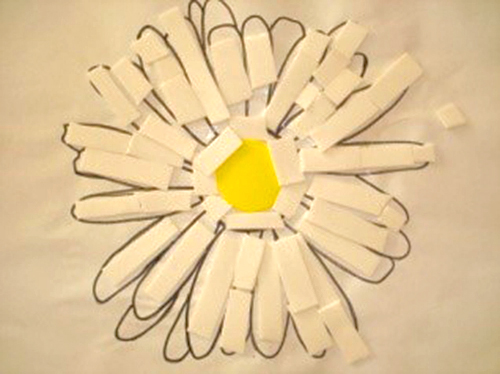|

By Vania Grande
Editor’s Note: The following article has been edited and summarized for publication in the English language.
Located in Valinhos, Brazil, Acesa is a non-profit organization that cares for children with disabilities, comprised of 45 staff members and therapists serving 75 clients and their families. The program provides multi-disciplinary professional services in the areas of education, speech therapy, equine therapy, physical therapy, occupational therapy, psychology, music, physical education, and arts. According to its late founder, Heloisa de Carvalho Crissiuma, the mission of Acesa is "To provide unconditional love and service, believing in the human being, in its infinite possibilities and its ability to transform and transcend any condition of life." Heloisa was a flower essence and Reiki therapist. Since 2009, I have helped to carry on her work as a flower essence therapist with the support of the
Flower Essence Society
and Healingherbs Bach flowers.
The following report covers highlights of a 9-week art and flower essence therapy project, administrated with the help of artist Vilma Piton. We served a group of 10 children with varying degrees of intellectual and physical limitations, including Down syndrome, autism, and difficulties with motor coordination and mobility. Our goal was to help each child develop in their soul life, learning how to better cope with their fears, joys and frustrations, despite significant disabilities.

For this project, I emphasized the therapeutic themes of flower essences in the Asteraceae/Sunflower family. This group of flower essences is generally very important for children with developmental disabilities due to the strong integrative aspects inherent in the botany of the Asteraceae. The flowers are dynamic yet precise in their mandala-like geometric structures. As a whole, these flowers speak to the Core Self as a radiant shining light or Sun, enhancing qualities of self-esteem, internal coherence, immune strength and inner resilience.
I assembled a special set of the
FES
Affirm a Flower affirmation cards
which included
Shasta Daisy
,
Chicory
,
Zinnia
,
Madia
,
Calendula
,
Sunflower
,
Chamomile
,
Echinacea
,
Black-Eyed Susan
,
Cosmos
and
Arnica
.

Flowers of the Asteraceae/Sunflower family
Left to right: Madia, Shasta Daisy, Zinnia, Chicory, Echinacea, Sunflower,
Calendula, Arnica, Chamomile, Black-Eyed Susan, Cosmos
The children were each invited to select their “special flower” from this set. The flowers chosen by the children were the following:
Zinnia
– This flower was chosen by 4 of the 10 children. This flower addresses the innate joy, spontaneity and carefree happiness that is the birthright of every child, and can be deeply deficient in children who have developmental difficulties and feel set apart from the social mainstream.
Chamomile
– Healing the core emotional stability of the child when there are many fluctuating and overwhelming emotional states.
Calendula
– Helping the tender, soft aspects of maternal nurturing; to nourish the receptive state of listening and being held as well as holding the social space of another.
Shasta Daisy
– A powerful integration flower that is especially beneficial for children with developmental challenges, helping to facilitate coherence and harmony within the internal structure.
Cosmos
– A key flower to help the communication process by directing the higher soul consciousness to come through the blocked areas of the brain and body.
Chicory
– To help transform many states of neediness and dependency, a developmental need for all children, and even more pronounced for those with disabilities.
Sunflower
– To nourish the core radiance and innate sense of Self that is at the heart of every human being, and especially the connection with the father or masculine identity in either sex.

We also added to each child’s individual flower choice,
Iris
and
Black-Eyed Susan
flower essences. The
Iris
was selected to nourish and support artistic creativity and soul expression while the
Black-Eyed Susan
was used to open the flow of higher light forces and remove obstacles and blockages to expression. A stock solution was then formulated for each child, consisting of their chosen flower essence along with
Iris
and
Black-Eyed Susan
, and administered regularly for the duration of the project. To our delight, the teachers of these children were also very interested in participating, leaving the role as leaders and allowing their own internal issues to be healed during this time with flower essences.

We met weekly and began our time together establishing a mood of quiet receptivity. Each child held the flower card they had selected and then took the flower solution internally. We also helped to seed the imagination of each child regarding their chosen flower, its qualities, colors and shapes, where it grows, and any particular experiences they may have had with the actual flower.
We worked with many different art mediums including watercolor brushes, wet sponges, bond paper and colored pencils, according to the special needs of each child. Our priority was to establish empathy and emotional connection. Our meetings always ended with a feeling of gratitude and deeper social bonding. The following are some examples of the children’s artistic creations along with our insights:
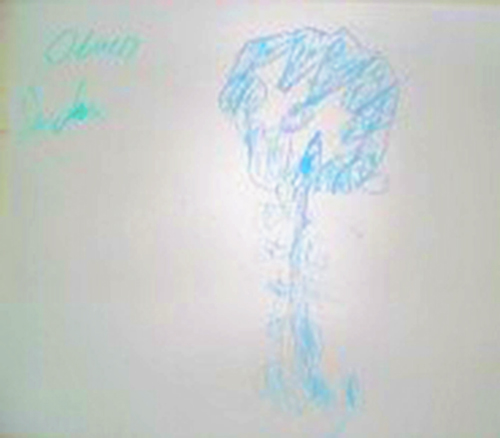
|
|
|
|
O. drew a
Sunflower
that is very amorphous, with the petals going into the center more than shining out. He has very large motor difficulty in both hands. Yet he was able to perceive his flower and achieve his expression.
|
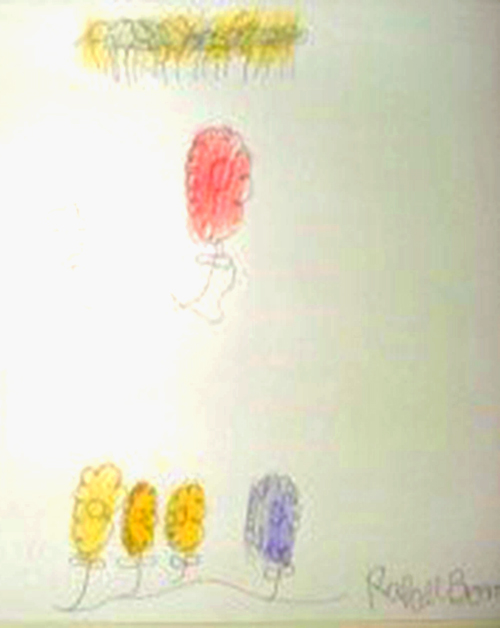
|
|
RB designed a garden and added clouds and lightning. He has schizophrenia and experiences intense tantrums. At the end of the meetings he is always asking about his flower solution, saying that he feels “relief” when taking it. “Relief” is an unusual vocabulary word for RB, and yet he used it more than once to describe how he felt taking the flowers. His chosen flower was
Calendula
, which provides gentle soothing and nurturing.
|
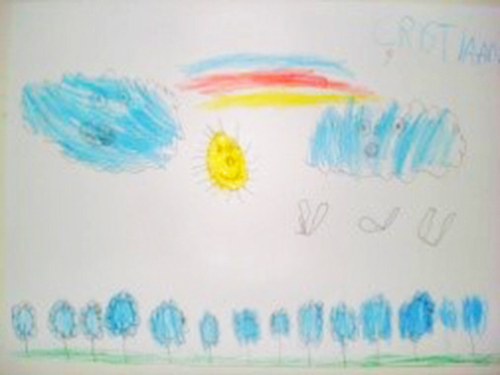
|
|
C. drew many
Chicory
flowers with large heads, painting them completely blue. She added a smiling sun, with two heavy clouds, a rainbow and birds. This painting expresses a desire for inner freedom and upliftment, a theme very prominent for a
Chicory
child.
|
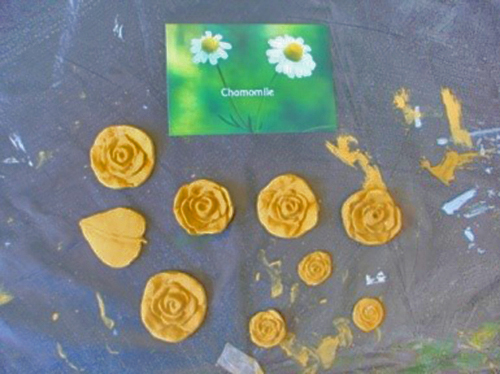
|
|
R. identified with the yellow raised center of the
Chamomile
flower. It is interesting that this part of the flower is related to the solar plexus of the human being. R. does not speak, and this process helped him build his identity and emotional well-being.
|
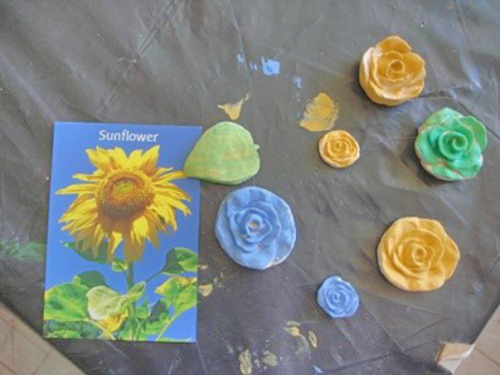
|
|
D. is autistic. When he chose the
Sunflower
, he said he likes to see this flower because it feels good and happy and he remembers his father when he sees the
Sunflower
. D. has
echolalia
, and always repeats the last word spoken by us. So, I asked the question several times, reversing the question, and the answer was every time:
Papa
. His teacher who is with him every day, was surprised and moved to tears by D’s emotional feeling for his father that he was able to express through encountering the
Sunflower
.
|
|
|
|
|
|
O. used the typical colors of the
Sunflower
in the first collage, but then softened it in the second collage, adding the air element of sky. He became visibly more relaxed and radiant in this process of creativity, smiling frequently.
|
|
|
|
RM made a collage of
Shasta Daisy
. The choice of
Shasta Daisy
is very significant because he is searching to find the white calm light of his soul.
|
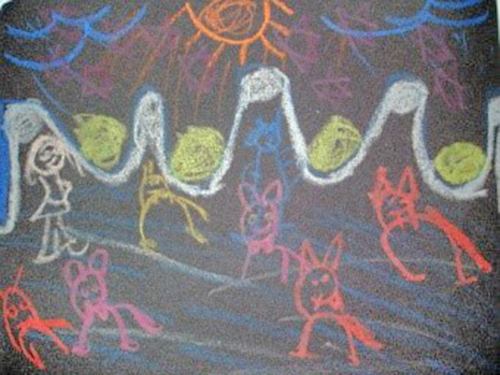
|
|
In a second drawing, he struggled with the darkness, drawing bats that were symbols of fear for him. He is trying to ascend the mountain, which is pointed like a pyramid. In the upper left-hand corner is a crescent Moon, suggesting deep emotional content that influences his soul.
|
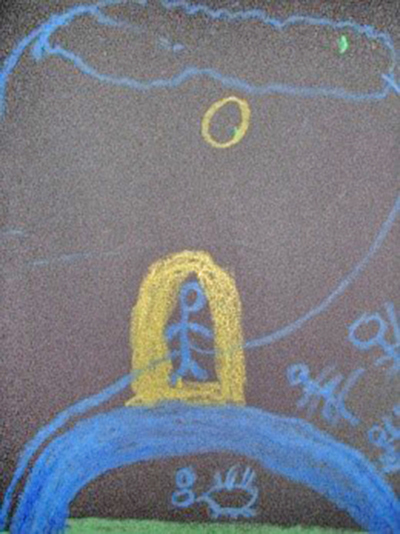
|
|
C.’s flower was the blue
Chicory
. Later she drew a blue mountain with yellow earth covering it. In the upper part is a cloud, and the moon, showing her longing for freedom.
|
In another session, we left the classroom, to experience the light of nature. As the children took their flower essences, I led them to imagine the earth and the mountains and the birth of the sun. They were each led to feel like little plants growing up out of the earth and discovering their place in the sun. I guided their attention toward the feeling of being born from the darkness of earth and growing into the light. We followed with an art session using white ceramic disks.
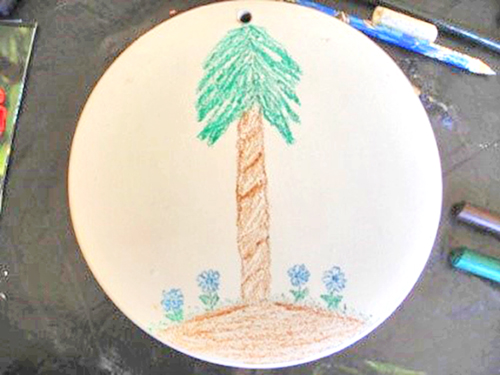
In the next meeting, we continued to celebrate the joy of flowering, and how it feels to allow the light to come into each of us. We made paper flowers using the kind of material and colors each preferred. This session was especially light-hearted. The social connection between all of us was very significant; we all helped each other with much laughter and festivity.

With this enhanced feeling of bonding together as a group, we now collaborated to create one unified collage on a wooden panel prepared with white paint. We then creatively added the flowers and leaves painted in a previous meeting. It was important at this stage in the project to have a creation coming from all our hands, filled with positive intentions, companionship, love and celebration. Our experience working together was so moving that all of us took turns shedding tears of compassion, joy and connection for each other.
The following are some of the feelings expressed while the children added their flowers to the collage:
"This flower I'm putting in is like the soul that all of us have inside."
"This flower will be always here in this school forever."
"I'm going to put in the blue Chicory flower." C.
"This is a red flower (Zinnia) I'll put it here for everyone to be happy."
"The flower is for my teacher who makes me feel so happy in the world."
"I am giving one flower for my teacher and one for my friend C. and another for my friend R.”
"I want to offer this flower to all the group, I don’t want these magic lessons to ever end. I love the group so much. And this cutest flower goes to the two wonderful teachers: Vania and Vilma.”
|
|
|
Vilma Piton (artist) and Vania Grande (floral therapist) with the mandala flowers
|
Conclusion
Art is a powerful tool of expression and transformation of the human being. Art uncovers the expressive creativity of the soul and is thus completely synergistic with flower essences. The integration of these two modalities has the power to bring out the true Self, the divine spark present in all of us, regardless of whether we have perfect physical bodies.
|
|
|
Vania Grande with the children's sculptures
|
Children with disabilities are typically marginalized in society. They are measured against so-called healthy or normal children, and are made to feel they are a mistake. We have an opportunity as therapists to help children with disabilities discover their essential goodness and self-worth as human beings. Art therapy combined with flower essence therapy is an amazing approach that transcends limitations and helps each one grow into one’s divine potential and the sacred identity of the Core Self. The process of working as group engenders compassion, joy, friendship, laughter and an expanded sense of social identity. Art and flower essence therapy help all of us to become better human beings.
About Vania Grande
Vania Lopes De Grande studied flower essence therapy with Cosmos Flower Therapy Institute and Rosana Vieira Souto in Campinas, São Paulo, Brazil. Vania has worked as a flower essence therapist since 2006.
She also does volunteer work in poor communities and institutions to support special needs children with learning difficulties, and their families. She serves as a volunteer with Regina Papp Gerald at Núcleo Mãe Maria in the village of Brandina in Campinas, and the Flower Essence Therapy Project in the Parque Centenário on the outskirts of the city of Campinas, which serves children, youth and adults in need.
Write to Vania
|

![]() and then Add to Home Screen.
and then Add to Home Screen.












